 |
||||||||||||
|
July/August 2015
BY LOUISE ESOLA James Kerr didn’t write many letters home before he died in a place his family would forever call Vietnam. They called him Big Jim. He was 18 years old, 6-foot-2, and handsome with blue eyes and thick brown hair. He had a pretty girlfriend, a turquoise muscle car, and a promising future—the dentist he worked with told him that if he went to dental school, he could work in the practice one day. But it was 1969. An unpopular war and an unpopular draft left young Americans like Jim with few choices. Everybody, it seemed, told him to go in the Navy—Mom, Dad, his classmates, that dentist. It was the safest bet, they said. And so Jim, less than a year out of high school, cut his hair short and enlisted. His father drove him to Naval Training Center in San Diego just after Valentine’s Day. Graduation followed in weeks—boot camp shortened to meet the needs of the war—as did his orders: a destroyer, U.S.S. Frank E. Evans, already in Vietnam, understaffed by about thirty hands. Kerr, part of a hastily gathered batch of fresh crewmen, caught up with the Evans by mid-May after a long plane ride to Southeast Asia. “Hello from the lousiest ship in the Navy!” he wrote, tongue in cheek, to his parents in Glendale, California. He had spent the day like most new seamen do, chipping paint, hauling food stores, marveling at the ship’s five-inch gun barrels. “We’ll be lobbing shells 24 hours a day for 28 days about three miles off the coast of the Mekong Delta,” he wrote in another letter. The way things were going, he’d miss his nineteenth birthday at home, he wrote in his last letter, dated June 1, 1969: “I’ll just sing ‘Happy Birthday’ to myself as we lob a six-gun salute at Hamburger Hill.” But in two days he was gone. The death report read, “drowning.” The location: “South China Sea.” To his brother Fred Kerr, it was Vietnam. To the United States government, which has long kept James Kerr off the Vietnam Veterans Memorial in Washington, D.C., it had nothing to do with the war. The U.S.S. Frank E. Evans was a creaky 24-year-old ship left over from World War II and Korea and kept on the line—worn and weathered like most of the Navy’s tin-can fleet—to fight in Vietnam. Chief of Naval Operations Adm. Thomas H. Moorer had told Congress just that at about the same time the Evans was parked on the gunline just south of Da Nang in May 1969. Meanwhile, Seventh Fleet memoranda stated that demand for naval gunfire support in Vietnam always surpassed availability. In early 1969 the Nixon administration circulated memos that called for American ships in the South China Sea off Vietnam to give the enemy—which had been stalling the peace talks—the sense that the United States was planning “something big.” In March, President Nixon ordered bombers into Cambodia to help cripple enemy supply lines. The sea was another supply route. The bluewater Navy’s part in the Vietnam War was deemed essential. Carriers toted bombers in and out of the warzone. Supply and troop carriers ferried men and supplies between the Philippines and Vietnam. At sea, smaller ships surveilled the shore. At the coast, cruisers and destroyers supported the carriers and acted as swift-moving mobile artillery units to support men on the ground.
A 2,200-ton cog in this massive war machine, the Evans left the port of Long Beach about two months earlier than originally scheduled. Among those on board were three brothers all under twenty-two years old—Gary, Greg, and Kelly Jo Sage of Niobrara, Nebraska—and a father-and-son pair— Lawrence Reilly, Sr., and Lawrence Reilly, Jr. Only Gary Sage had reservations about being on board a warship with his kin. If something happened, he told a girl in his small hometown, the family could lose all of them. Meanwhile, Chief Lawrence Reilly, Sr., had worked on a cruiser during World War II, dodging Japanese submarines. The Navy of the 1960s and the war, he used to say, was a very different beast. The American ships fired guns, the chief once said, and nobody did anything to stop them. By mid-May the Evans, which had been deploying to the Vietnam theater since 1965, had wrapped up its part in Operation Daring Rebel, a search-and-destroy operation involving four thousand Marines targeting Viet Cong hideouts on the Barrier Island just south of Da Nang. The ship had fired more than two thousand 50-pound shells into South Vietnam over ten days, destroying nearly two dozen enemy structures. Exhausted from the gunline duties and in need of replenishment, the ship cruised to Subic Bay in a roundabout way that was considered the norm for any fighting Seventh Fleet warship. They would be heading back, several Evans sailors and officers wrote home. At Subic Bay the ship picked up twenty-eight new recruits, along with a full war allowance of ammunition. But before returning to Vietnam, there was a major sea exercise to tackle. The Evans was selected to participate in a large multinational antisubmarine warfare exercise under the auspices of the Southeast Asia Treaty Organization. The United States had been participating in such show-of-force exercises since the 1950s. In 1966, when the war in Vietnam heated up, the Seventh Fleet weighed the decision to continue such exercises given the demands for naval gunfire support. But the fleet’s planners concluded that the exercise area would be close enough to Vietnam that, if needed, the ships could be redirected to the gunline of Vietnam or the Tonkin Gulf. The 1969 exercise, dubbed Sea Spirit, involved forty vessels from seven nations. The opening ceremony, full of saber-rattling, included speeches by dignitaries and military leaders. Not one omitted the word “Vietnam” to describe the importance of showcasing force, of perfecting collaboration, and of occupying the waterways close to the warzone. Deep in the details of Sea Spirit, an exercise that called for locating and eliminating “enemy” submarines, was a more specific, peripheral directive: Sino-Soviet jamming. The operation order told all vessels involved that the enemy would likely be in their midst and that their radio communications were to be harassed. The armada was slated to arrive in Thailand by June 5.
Sea Spirit was a tiresome ordeal. “Always something coming up,” the Evans’s skipper Commander Albert McLemore said. The Evans had to revert to old protocols, some last used when half the complement was still in high school. One sailor called the operation a “farce” in a letter home. “I only hope our well-being never depends upon such a group as this,” wrote John Spray, a 25-year-old sonar technician who had been in the Navy for nearly four years. As planned, the Evans was among five destroyers and frigates accompanying the flagship of the Royal Australian Navy, H.M.A.S. Melbourne. There was confusion at times and frustration from the top to the lowly bottom. Some of the ships lacked procedural manuals and were given faded mimeograph sheets. The radios were too noisy, McLemore later said. One American destroyer had nearly crashed into the hull of the Australian carrier. Two days later, a Thai ship collided with a British oiler, fortunately with no injuries or major damage. On June 2 an American admiral sent a memo to the skippers of the American ships, chiding them for “sloppy maneuvering.” A naval historian later described this era in American naval surface warfare as the “doldrums,” with surface officer billets staffed at 81 percent. Some blamed the aging fleet. Others blamed the unpopular war in Vietnam. There were “leadership deficiencies” and a “collision situation,” a Seventh Fleet document noted in early 1969. On board the Evans, all but three of its officers had been in the Navy for more than two years. Billets intended for more senior officers had been assigned to younger ones. A large exercise involving foreign navies—and on some nights, treacherous darkened-ship conditions—was no easy task, experienced ship handlers later testified. Esquire magazine’s July 1969 issue hit newsstands with a feature entitled “Esquire Magazine’s Official Board of Inquiry into the Status of the United States Navy.” It highlighted all the mishaps since 1965, including the deadly 1967 fire on the U.S.S. Forrestal.
Within hours of the damning memo of June 2, an exhausted McLemore went to his sea cabin after what was rumored to be thirty-six hours without sleep. He left two inexperienced young officers in charge on what was supposed to be a quiet night. Tragedy struck in the early morning hours of June 3, when the 22,000-ton Melbourne slammed into the hull of the much-smaller Evans, which had turned directly in her path during a maneuver that would have seasoned Navy men scratching their heads for decades: You never turn in the path of an aircraft carrier, which can only turn or stop with difficulty. The Evans, sliced in half, rolled to her side. The aft section righted itself almost im Only one body was recovered. The death toll was seventy-four: James Kerr, the Sage brothers, Lawrence Reilly, Jr., and sixty-nine others were never seen again. The Seventh Fleet press office in Saigon first put the collision at “200 miles off the coast of South Vietnam” in a rough draft of a press release. Within hours it became “650 miles from Manila.” One reporter, relying on information from the Pentagon, put the collision at sea in the “South Pacific.” At the time, the embattled Nixon administration was dealing with a hailstorm of controversy: a growing antiwar movement, war-weary politicians, and no end in sight to a war that Nixon had promised to end—a war that was taking some three hundred American lives a week. The Viet Cong had just retaken their positions on a place called Hamburger Hill. Although seventy-two Americans had been killed securing the area, the hill had been abandoned days later. The administration wanted a tragedy with seventy-four deaths to be as far away from Vietnam as possible.
Today the official story is that the Melbourne-Evans collision happened about 120 miles outside the official Vietnam War combat zone. So say the Navy and the Department of Defense, relying on a perimeter sketched by President Johnson in 1965 that determined whose pay is tax exempt. This designated combat zone—fluid lines that at first erroneously did not include Cambodia or Laos—is what keeps the names of the seventy-four casualties from the U.S.S. Frank E. Evans off the Vietnam Veterans Memorial. It’s a decision that a group of veterans and families has been fighting to reverse for decades. They will continue to do so “until it’s done,” said Steve Kraus, a survivor and vice president of the U.S.S. Frank E. Evans Association. Kraus fires off emails from his home office in Oceanside, California. He claims lots of precedents. The Pentagon has added other names to The Wall of men killed outside of the combat zone, including sixty-eight Marines who died in Hong Kong, a man who killed himself on U.S. soil after coming home, and a man who died of a heart attack in a hospital in Guam. The men of the Evans, along with those on all the American ships involved in Sea Spirit, were awarded Vietnam Service Medals. Kraus and others believe that medal—given to ships, units, and individuals supporting the war—fits criteria for inclusion on The Wall. Officials with the Navy and the Department of Defense either have remained silent on these details or have stuck to the original, false claim that the Evans was not involved in the war at the time. It was outside of the combat zone, they say—end of story. Kraus, family members, lawmakers, and journalists have been at it for nearly two decades. The issue has come up in Washington at least five times, but always has been lost in the bureaucracy.
The California memorial is a circular granite and bronze structure that stands in the manicured northeast corner of Sacramento’s state capitol grounds (See May/June 2014 issue of The VVA Veteran). It includes more than 5,800 names of the fallen etched in its ink-black panels. It now also includes the names of the twenty-two Californians who were killed on the Evans, including James Kerr. His brother Fred Kerr was among several dozen family members who attended the ceremony in Sacramento. James Reilly, who lost his brother Lawrence Reilly, told television news crews that it’s time for Washington to follow suit. The issue in Washington is moving slowly. Last year the U.S. House of Representatives, urged by Rep. Adam Schiff (D-Calif.), included in its version of the 2015 National Defense Authorization Act an amendment urging the Secretary of Defense to order that the seventy-four names be added to The Wall. The 2015 amendment did not make it into the Senate’s version of the bill—an exclusion several lawmakers have linked to partisan politics—but was included in an explanatory statement for President Obama. It said: “We recommend that the names of the seventy-four military personnel lost aboard the U.S.S. Frank E. Evans on June 3, 1969, be added to the Vietnam Veterans Memorial.” By then, Secretary of Defense Chuck Hagel had resigned and wouldn’t comment—a move that incensed several Evans survivors and the surviving Sage brother, Doug Sage, who was six years old when he lost his brothers. Hagel, a former senator from In June, Sen. Chuck Schumer (D-N.Y.) launched his campaign to have the seventy-four recognized by Memorial Day 2016—a major push by a senior senator. New York lost five men on the Evans. “It is a mistake and an injustice that seventy-four veterans bravely served their country in the Vietnam War and cannot be recognized on the national Vietnam [Veterans] Memorial Wall because of an overly strict and inflexible interpretation of a bureaucratic rule. These sailors served their country well, both inside and outside the combat zone, and the collision that caused these brave Americans to lose their lives should be considered directly linked to the war,” Schumer said. Within two weeks of Schumer launching his effort, the office of the Secretary of the Navy responded favorably to his request that the names be added. In late June, Schumer’s office petitioned the Department of Defense directly. Pentagon spokesperson Lt. Cmdr. Christensen gave this response to the Navy’s endorsement: “Our policy is that casualties that occur as a result of training incidents are not eligible for induction on the Vietnam Wall.” He would not comment on exceptions that have been made in the past. Meanwhile, a recent legislative effort that would have forced the Pentagon to reverse its position failed in its infancy. A stronger amendment to the 2016 National Defense Authorization Act was rejected, inexplicably, by the House of Representatives Rules Committee, according to Rep. Schiff, who introduced the measure. The California lawmaker says he’s enlisted the help of others and is not giving up. “I was disappointed that the House Rules Committee disallowed my amendment to the National Defense Authorization Act,” he said. “I am continuing to pursue this matter directly with the Pentagon, and am hopeful that the new secretary of defense will give the issue the time, attention, and action it deserves. I am also heartened by increasing support from my colleagues in the Senate, and hopeful that our bipartisan, bicameral effort will be persuasive.” Randy Henderson, a New Yorker who lost his brother Terry Lee Henderson on the Evans, believes this latest effort will work. “This will not go away,” he said. “My brother died in the Vietnam War. That’s why he was there. There should be no question.” His mother, 87-year-old Maryann Buettner, is hopeful she’ll one day see her son’s name on The Wall. Names are added on Mothers Day each year. Five mothers of Evans casualties are still alive. “He should be on The Wall with the rest of the boys,” Buettner told a television news crew in June. “They should all be on that wall.”
|
||||||||||||
|
|
||||||||||||
|
||||||||||||
8719 Colesville Road, Suite 100, Silver Spring. MD 20910 | www.vva.org | contact us |
||||||||||||















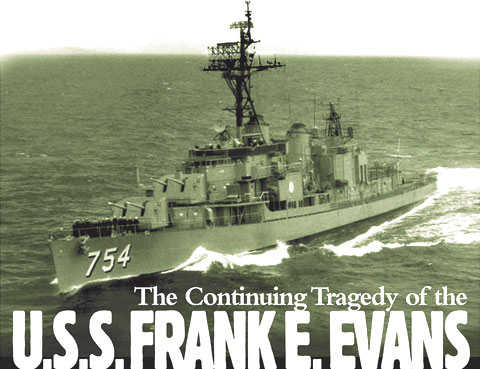
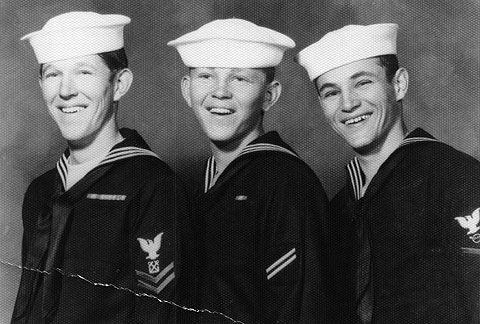
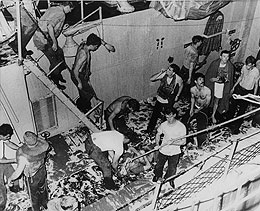 The article would soon be outdated by the second largest single loss of life suffered by the United States Navy in the Vietnam War.
The article would soon be outdated by the second largest single loss of life suffered by the United States Navy in the Vietnam War.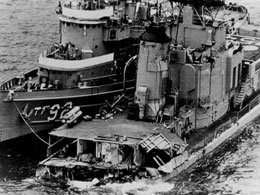 mediately and drifted along the starboard side of the Melbourne. The Evans’s bow, where ranks and ranks of young sailors slept, never recovered and sank in three desperate, deadly minutes. The few survivors from the front half of the Evans clamored for their lives in a scene they would revisit in nightmares.
mediately and drifted along the starboard side of the Melbourne. The Evans’s bow, where ranks and ranks of young sailors slept, never recovered and sank in three desperate, deadly minutes. The few survivors from the front half of the Evans clamored for their lives in a scene they would revisit in nightmares._post_collision.jpg)
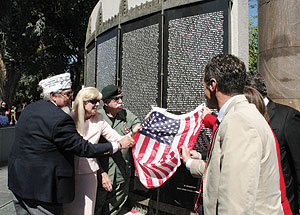 A major battle was won on March 29, when the state of California unveiled its latest additions to the California Vietnam Veterans Memorial. It was, coincidentally, the 46th anniversary of the Evans crew leaving Long Beach to do their part in the Vietnam War.
A major battle was won on March 29, when the state of California unveiled its latest additions to the California Vietnam Veterans Memorial. It was, coincidentally, the 46th anniversary of the Evans crew leaving Long Beach to do their part in the Vietnam War.